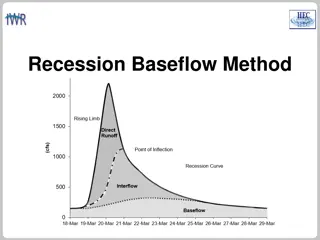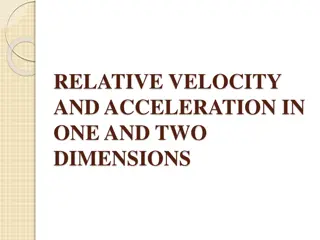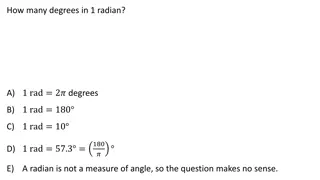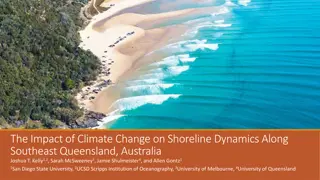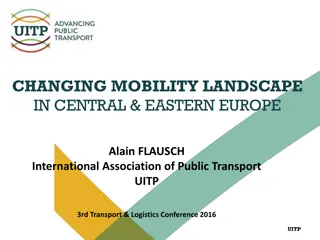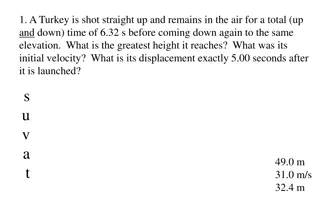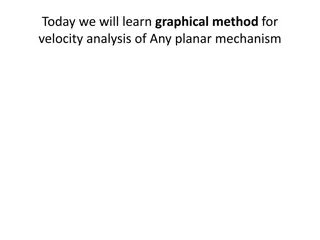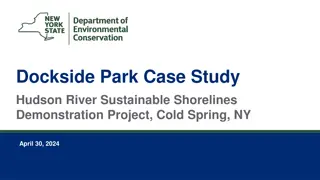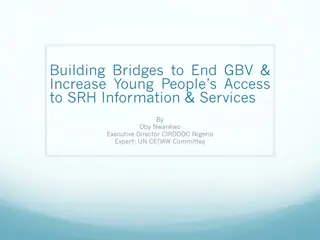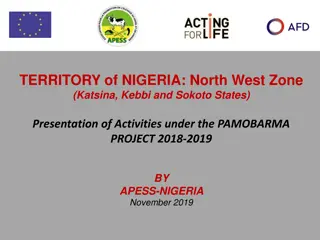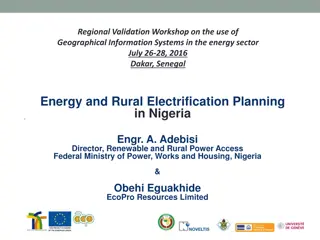Analyzing Shoreline Recession and Estuarine Current Velocities in South-Eastern Nigeria
Coastal submergence and shoreline retreat due to sea-level rise and climate change pose threats to shoreline management in the Niger Delta. This study focuses on analyzing shoreline recession and estuarine current velocities in south-eastern Nigeria, using techniques like shoreline mapping and beach profile surveys. The results highlight the impact of sea-level rise on the region's coastline and provide insights for effective coastal management strategies.
Download Presentation

Please find below an Image/Link to download the presentation.
The content on the website is provided AS IS for your information and personal use only. It may not be sold, licensed, or shared on other websites without obtaining consent from the author.If you encounter any issues during the download, it is possible that the publisher has removed the file from their server.
You are allowed to download the files provided on this website for personal or commercial use, subject to the condition that they are used lawfully. All files are the property of their respective owners.
The content on the website is provided AS IS for your information and personal use only. It may not be sold, licensed, or shared on other websites without obtaining consent from the author.
E N D
Presentation Transcript
BY SAVIOUR P. UDO-AKUAIBIT INSTITUTE OF NATURAL RESOURCES, ENVIRONMENT AND SUSTAINABLE DEVELOPMENT, UNIVERSITY OF PORT HARCOURT, RIVERS STATE, NIGERIA. at the 2nd International Conference on Oceanography, Las Vegas, USA., July 21-23, 2014.
OUTLINE INTRODUCTON STUDY AREA&TECHNIQUES RESULTS/DISCUSSION SUMMARY CONCLUSION
INTRODUCTION Coastal submergence and shoreline retreat are global problems which can be attributed to sea- level rise and climate change. These constitute a serious threat to shoreline management in the Niger Delta. This study is therefore aimed at analyzing shoreline recession as a result of sea level rise and also examines the impact on the strand coast, south eastern Nigeria.
STUDY AREA &TECHNIQUES Period Sept.28- October 6, 2013 Shoreline Mapping with GPS and camera. Wave breaker parameters Beach profile surveys
The 2002 And 2013 Editions Of The Shoreline Maps Of The Study Area
STUDY AREA Plate 1: Aerial photo of Qua-Iboe Estuary in 2002
Plate 2: Aerial photo of Qua-Iboe estuary showing areas of severe erosion in 2002
RESULT-ESTUARY: Current Velocities Estuarine current velocity-Updrift Estuarine Current: Downdrift North North 150 150 100 100 Velocity (cm/s) Velocity(cm/s) 50 50 Neap Tide Neap Tide 0 Mean Tide Mean Tide -20-18-16-14-12-10 -8 -6 -4 -2 0 2 4 6 8 10 0 -50 Spring Tide Spring Tide -20-18-16-14-12-10 -8 -6 -4 -2 0 2 4 6 8 10 -50 -100 -150 -100 Time in half hourly interval relative to high water(0) Time in half hourly interval relative to high water(0) South South Fig.4.Estuarine current velocity-Updrift Fig.5.Estuarine current velocity:downdrift Average Flow Velocity:Estuary- Updrift Average Flow Velocity: Estuary- Downdrift 60 80 70 50 Velocity (cm/s) Velocity(cm/s) 60 40 50 30 40 30 20 20 10 10 0 0 Neap Tide Mean Tide Spring Tide Neap Tide Mean Tide Spring Tide Neap Tide Mean Tide Spring Tide Neap Tide Mean Tide Spring Tide Flood Tide(Northward) Ebb Tide(Southward) Flood Tide Ebb tide Fig.6.Average Flow Velocity:Estuary updrift Fig.7 Average Flow Velocity: Estuary Downdrift
RESULT-SURF ZONE: Longshore Current Fig. 9: Longshore current velocity:Downdrift station 1 Fig. 8: Longshore current velocity:Updrift station 1 East East 100 150 100 50 Velocity (cm/s) Velocity(cm/s) 50 Neap Tide Neap Tide 0 0 Mean Tide -20-18-16-14-12-10 -8 -6 -4 -2 0 2 4 6 8 10 Mean Tide -20-18-16-14-12-10 -8 -6 -4 -2 0 2 4 6 8 10 Spring Tide -50 -50 Spring Tide -100 -100 West -150 Time in half hourly interval relative to high water(0) Time in half hourly interval relative to high water(0) West Fig.10: Average Longshore Current Velocity: Updrift-Station 1 Fig. 11: Average Longshore Current Velocity:Downdrift Staiton 1 120 70 100 Velocity (cm/s) 60 Velocity (cm/s) 80 50 60 40 40 30 20 20 10 0 0 Neap Tide Mean Tide Spring Tide Neap Tide Mean Tide Spring Tide Neap Tide Mean Tide Spring Tide Neap Tide Mean Tide Spring Tide East West East West
RESULT-SURF ZONE: UPDRIFT.ST.2 -WAVE PARAMETER Fig 12: Wave Breaker height:Updrift Fig 13: Wave Breaker Height: Downdrift 30 Wave Breaker Height(cm) 25 70 Wave Breaker Height(cm) 60 20 50 15 40 Neap Tide Neap Tide 10 30 Mean tide 20 5 SpringTide 10 0 0 -20-18-16-14-12-10 -8 -6 -4 -2 0 2 4 6 8 10 -20 -18 -16 -14 -12 -10 -8 -6 -4 -2 0 2 4 6 8 Time in half hourly interval relative to high water(0) Time in half hourly interval relative to high water(0) Plate 3.Wave breaker Height -Updrift Plate 4: Wave breaker Height- Downdrift.
RESULT-UPDRIFT:BEACH PROFILE Beach Profile:Updrift -Station 1 Beach Profile:Updrift-Station 2 40 40 20 20 0 Elevation(cm) 0 1 2 3 4 5 6 7 8 9 10111213141516171819 0 Elevation(cm) -20 Neap Tide 0 1 2 3 4 5 6 7 8 9 1011121314151617181920 Neap Tide -20 Mean Tide -40 Mean Tide Spring Tide -60 -40 Spring Tide -80 -60 -100 -80 Distance(x10m) Distance(x10m) Fig.14.Beach Profile: Updrift-Station 1 Fig.15. Beach Profile: Updrift Station 2 Plate6: Foreshore Updrift Station 2 Plate 5:Backshore - Updrift Station 1
RESULT-DOWNDRIFT:BEACH PROFILE Beach Profile:Downdrift-Station 1 Beach Profile:Downdrift-Station 2 30 60 20 40 10 0 20 Elevation(cm) Elevation(cm) 0 1 2 3 4 5 6 7 8 9 10 11 12 13 -10 Neap Tide 0 Neap Tide -20 0 1 2 3 4 5 6 7 8 9 10 11 12 13 14 15 Mean Tide Mean Tide -20 -30 Spring Tide Spring Tide -40 -40 -50 -60 -60 -70 -80 Distance(x10m) Distance (x10m) Fig.16.Beach Profile: Downdrift Station1 Fig17.Beach Profile: Downdrift-Station 2 Plate 7: Foreshore- Downdrift Station 1 Plate 8: Foreshore- Downdrift Station 2
HYDRODYNAMICS-EBB PHASE Plate 9. Offshore sand bar Updrift.
SHORELINE MANAGEMENT ISSUES Plate 10 Stubb s Creek sealed-up with sediment during storm surge in 2011 Plate 11: Foreshore trough at updrift beach Plate 13 shoreline retreat due to storm surge event at the updrift Plate 12: Eroded backshore at updrift beach
SHORELINE MANAGEMENT ISSUES Plate 14:Former Itak Abasi primary School damaged by storm surge in 2011 Plate 15: Former Itak Abasi Health Centre damaged by storm surge in 2011 Plate17: sediment accretion at downdrift beach Plate 16: Ibeno beach resort
SUMMARY This presentation has : Noted shoreline retreat and coastal submergence around Qua-Iboe Estuary as impact of sea-level rise and climate change in Nigeria. Considered integrated coastal zone management approach as essential in managing the shoreline retreat through intervention projects by both public and private sectors. Considered regular beach nourishment as a proactive measure to prevent shoreline retreat
CONCLUSION In conclusion, the coastal submergence and shoreline retreat along the south east coast of Nigeria which is attributed to sea-level rise related storm surge can be considered as a signature of climate change in Nigeria. Therefore, more attentions should be given and concerted effort made by the government and private sectors to reduce any anthropogenic activity which accelerate climate change and sea-level rise.
CONTRIBUTION TO KNOWLEDGE The production of a recent shoreline map of the study area as a basis for assessment of sea-level rise along the strand coast of Akwa Ibom State, South-eastern Nigeria.
THANK YOU FOR LISTENING






